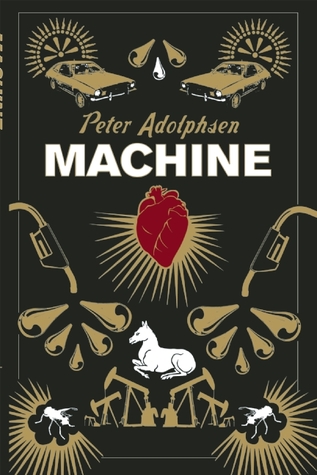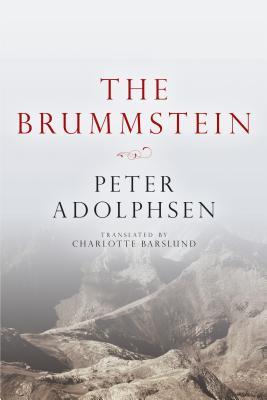The passage of fifty-five millions years sounds extremely epic, but here, in Peter Adolphsen’s Machine (2006, tr. Charlotte Barslund, 2007) that passage in time is compressed into the less monumental count of eighty-eight pages. Granted, when averaging 625,000 years per page, a book of this length and that time span isn’t going to linger long on details; what we therefore have is an exercise in style, following the intersecting path of an oil droplet and a couple in a car.
Adolphsen’s narrator opens by telling us that in 1975 a drop of petrol combusted in a car engine, converting to exhaust fumes. This minor event, trivial and unnoticed, finds its place in a larger system.
The universe is in possession of such immense quantities of matter, space and time that it is possible, through changes caused by changes, to try out endless combinations resulting in the present huge number of structures ranging from amino acids to galaxy clusters. The story of a speck of matter is thus the story of these spontaneous structures and their altered states.
As if to demonstrate this ever-changing nature of the universe, we quickly learn another such way that this initial explosion can express itself.
…the drop acquired its most unstructured state in the form of exhaust fumes, yet managed nevertheless in this state, twenty-four hours later, to bring about a structure both complex and chaotic: cancer.
Machine, therefore, is the story of chaos theory in action, a number of random coincidences creating an ever-flowing pattern of cause and effect. Although a truer starting point may well be the Big Bang (or whatever came before it), we’re introduced to the early Eocene period, at the end of a hot misty day as a herd of Eohippus, a tiny horselike creature, gather around a lake. A spark – the universe is always in motion – of lightning triggers the last days of one particular eohippus, its heart destined to become the fossil fuel that will bring about the aforementioned cancer, although we are invited to ponder this telling when the narrator makes a claim that seems unknowable.
I know this because I was eavesdropping from the neighbouring balcony as she inhaled the particles which triggered the pathological cell division.
Indeed, how could someone narrating today know such details about the past? While explained, Adolphsen’s prose is not without its games (though not the tricksy or charming sort) as he advances through a sequence of postmodern techniques: lists (and lists within lists), most notably an inventory of peoples of the Soviet Union of Socialist Republics; sentence structure in a breathless, page-spanning LSD trip that manifests as an unpunctuated, lower case, single sentence; and regular short digressions into seemingly random topics (The Book of Mormon, poet Kenneth Rexroth, the Ford Pinto, etc) that slot nicely into the greater narrative. While he dispenses with the passing of time in a mere matter of words, he is content to slow things down, exhausting the minutiae of a split second.
While not exactly an instant, the novella lingers longest in 1975, where we meet its two key characters. First, Jimmy Nash, an Azerbaijani immigrant chasing the American Dream (only to find himself working in the same industry he left behind: oil); and Clarissa Sanders, a biology student for whom greater understanding of ourselves via controlled experiments will further humanity. Their subsequent road trip is well done, exploring various subjects in tune with the novella’s themes. At one point they find themselves lost, and a brief exchange between them highlights an acknowledgement of the grander perspective on show in Machine:
Where did you come from?’ he asked, attempting to reverse the logic. ‘Perhaps you need to go back to your starting point in order to know where you want to go.?’
‘That’s a bit feeble, don’t you think? Surely all you’ll learn is wherever you wanted to go at that time. Besides ‘my starting point’, where is that? When I got out of bed this morning? The hospital where I was born? The country my ancestors came from? And which ancestors? The apes?
The novella is full of machines: cars, the human body, Soviet regimes, marketing, and more. Ultimately, these are all cogs in the larger system, that seemingly random universe (chaotic or organised, your call!); just as our eohippus, Jimmy, Clarissa, and every page, sentence, word, and letter are part of the book. It’s all information being passed along.
Machine isn’t the sort of book you settle down with for thrills or step-off-the-page characters, but as a literary exercise it works on its own terms. Its narrative delivers bald facts of life with cold scientific terminology, but even in the vastness of time, within the complex structure of coincidence, there are moments of warmth that shine through and find meaning in the ultimately meaningless.

